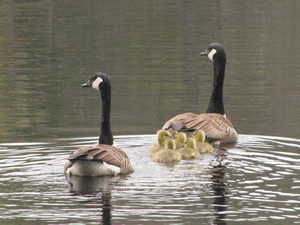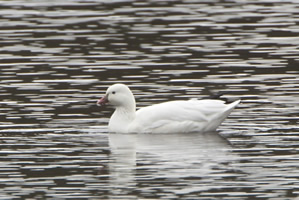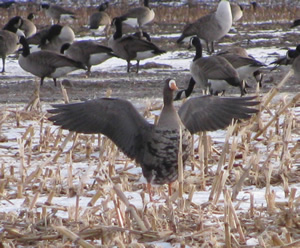Sharon’s Goose Guests
 Many years ago, it is said, Sharon folks maintained flocks of what are called Judas or toller geese. These Canadian geese (Branta canadensis) stayed put and did not migrate. (Geese raised in captivity never learn to migrate.) Their purpose was to lure wild geese down out of the skies. Then, as was the custom, these avian guests would be invited by Sharon families to their Christmas dinners. The descendants of Sharon’s once-perfidious fowl still follow in their forebears’ footsteps, but in a more agreeable way.
Many years ago, it is said, Sharon folks maintained flocks of what are called Judas or toller geese. These Canadian geese (Branta canadensis) stayed put and did not migrate. (Geese raised in captivity never learn to migrate.) Their purpose was to lure wild geese down out of the skies. Then, as was the custom, these avian guests would be invited by Sharon families to their Christmas dinners. The descendants of Sharon’s once-perfidious fowl still follow in their forebears’ footsteps, but in a more agreeable way.
Many geese gather on Wolomolopoag Street, which lies between the Ward’s fields off South Main Street.  The fields provide good gleaning for the geese, and Wolomolopoag Pond, just across South Main Street, is ideal for avian aquatic activities. When the word is out that Sharon’s geese have attracted yet another uncommon goose species, expect to see vehicles parked along the road, their occupants emerging with bird identification books, binoculars, and telescopes. This year the guest goose of honor was a white Ross’s goose (Anser rossi), whose usual habitat is the central Arctic/northern Canada. While the not particularly rare there, its appearance in Sharon is unusual.
The fields provide good gleaning for the geese, and Wolomolopoag Pond, just across South Main Street, is ideal for avian aquatic activities. When the word is out that Sharon’s geese have attracted yet another uncommon goose species, expect to see vehicles parked along the road, their occupants emerging with bird identification books, binoculars, and telescopes. This year the guest goose of honor was a white Ross’s goose (Anser rossi), whose usual habitat is the central Arctic/northern Canada. While the not particularly rare there, its appearance in Sharon is unusual.
Similar to the Ross’s goose but larger is the snow goose (Chen caerulescens). Their plumage may be white, as their name suggests, but also blue-gray. They breed, as does the Ross’s goose, in northern Canada and increasingly around Hudson Bay.
 The greater white-fronted goose (Anser albifrons) appears from time to time among Sharon’s flock. Grey-brown in color with bright orange legs and feet, it is named for the patch of white feathers bordering the base of its bill. It is an inhabitant of the mid-Arctic tundra.
The greater white-fronted goose (Anser albifrons) appears from time to time among Sharon’s flock. Grey-brown in color with bright orange legs and feet, it is named for the patch of white feathers bordering the base of its bill. It is an inhabitant of the mid-Arctic tundra.
The barnacle goose (Branta leucopsis) comes to us from its breeding grounds on Arctic North Atlantic islands, Greenland, and the Scottish Isles. It has a black back and white belly. In medieval times, the barnacle goose was thought to have grown from barnacles attached to drifting wood in the ocean.
Worldwide, goose populations are sizable and increasing (conservation status: “least concern”). This may be due to remote and inaccessible breeding grounds.
Nevertheless, these outsiders are rare enough in the Sharon area to make quite a splash!
To keep abreast of our goose guests, check Massbird.org. And if you spot some goose-watchers along Wolomolopoag Street, stop and ask for a look through their binoculars. Birdwatchers are generally friendly, fact-filled folk.
